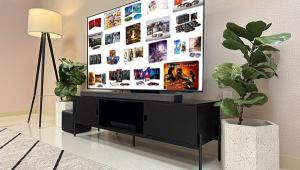Philips 34PW9819 34-inch HDTV Monitor Page 3
The TV also did a very credible job of capturing the film's desaturated brown/orange color palette, which the director of photography used to mimic the look of low-budget 1970s films. Finally, a scene in a dark store where the teens stop for gas revealed the set's impressive shadow definition. As the camera panned across the gloomy interior, I could clearly see pictures and objects cluttering the walls in the background.
|
With most TV companies switching their focus to pricey flat-panel technologies like LCD for 40-inch and smaller screen sizes, there's a good chance that TVs like the Philips 34PW9819 aren't going to be around much longer. That's a shame, because LCD can't touch tube-based sets on certain aspects of performance, like shadow detail and picture contrast. If you're a stickler for video quality and are looking for a reasonably priced widescreen set for watching DVDs and HDTV, this Philips is definitely worth looking into. It may not have all the flexibility and features of some other 34-inch HDTVs I've tested, but with a street price around two grand, it gives new meaning to the phrase "reality TV."
In the Lab
Color temperature (Warm color-temperature setting before/after calibration) Low window (20-IRE) NA/6,391 K High window (100-IRE) 8,212/6,487 K
Brightness (Warm color-temperature setting before/after calibration, 100-IRE) 20.3/23.4 ftL
With its Warm color-temperature setting selected, the Philips 34PW9819 displayed a blue bias at both ends of the grayscale. After calibration using the set's service menu, it had excellent grayscale tracking, measuring within ±100 K of the NTSC standard of 6,500 K through its entire range. (Calibration needs to be performed by a qualified technician with specialized equipment, so discuss it with your dealer before purchase, or call the Imaging Science Foundation at 561-997-9073.)
Focus was excellent, but picture overscan was 5% or above on all sides - higher than average. Using the color-decoder-error pattern on the Avia test disc, I measured only a small (+5%) error on the red channel. Scan-velocity modulation couldn't be defeated, although its effects were mild. The set's 3-D digital comb filter performed extremely well when a composite-video connection was used, with minimal cross-color artifacts visible on either test patterns or TV programs.
- A.G.













































